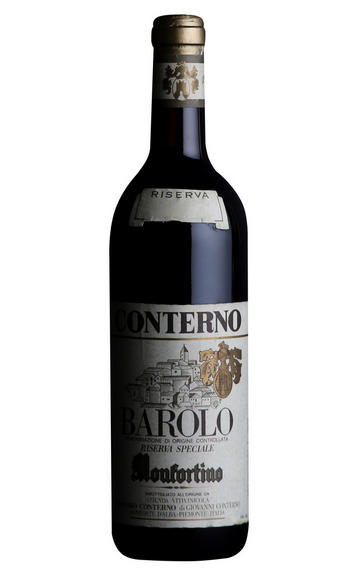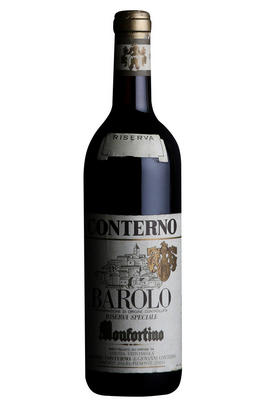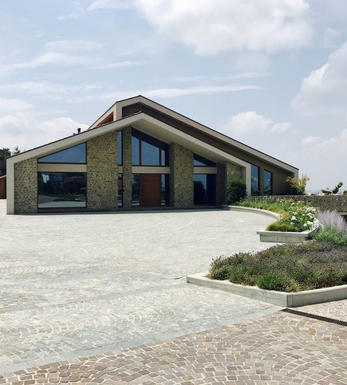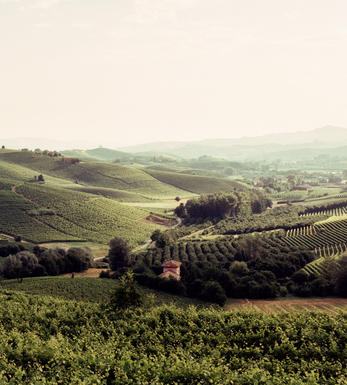
2004 Barolo, Monfortino, Riserva, Giacomo Conterno, Piedmont, Italy

Critics reviews
The 2004 Barolo Riserva Monfortino is drop-dead gorgeous. I have tasted the wine multiple times from barrel and three times from bottle and never been anything less than blown away. The 2004 is a subtle, layered Monfortino that captures the sheer elegance and finesse of this great vintage. It is sweet, perfumed, silky and utterly mind-blowing. From barrel it has always been a 100 point wine, but it has just been bottled and naturally a bit closed in on itself. Still, with some time in the glass its silky, perfumed fruit and dazzling class come to life.
The 2004 is remarkably harmonious for such a young wine. Readers will have much fun debating which is the greatest Monfortino of recent years. Could it be the 1996, 1999 or 2002 for their huge structure and classicism? Or, is it the 1997 for its opulence? What if the dark horse 1998 and 2000 steal the show? Personally, I adore the 2001 and 2004 for their completeness, but the 2004 is the sexiest of them all. Sadly, 2004 is also the year Giovanni Conterno passed away, but one can’t escape the feeling his spirit lives in this wine. Kudos to Roberto Conterno and his team for this magnificent, thrilling Barolo.
Anticipated maturity: 2019-2044. The drive from Barolo to Monforte was a little different this year. Peering across the valley over the hillside where the Conterno winery sits, the observant eye will notice a number of large barrels outside the main building. Roberto Conterno had no choice but to replace a number of his casks this year as the staves had begun to bend from many years of use, and Conterno was understandably afraid of the unthinkable, that the casks could finally yield to old age full of wine. Still, he was clearly upset by having to replace barrels that he personally moved into the new winery with his father during the summer of 1985. Just to think of the wines that were racked during that move.
The 1978, 1979 and 1982 Monfortini were still in cask. To be honest, seeing the empty space in the winery as the new casks were about to arrive was quite a shock. The wines, however, were not. I tasted all of the wines currently in cask plus the new releases from bottle. My high expectations were easily surpassed. Conterno fans have a lot to look forward to. Roberto Conterno has decided to give his new Nebbiolo from the Cerretta vineyard another year in barrel. At the moment Conterno is leaning towards releasing the 2009 as a Langhe Nebbiolo rather than Barolo, although that could always change.
Readers who want to learn more about the 2011 harvest at Conterno may want to take a look at my video interview with Roberto Conterno.
Drink 2019 - 2044
Antonio Galloni, Wine Advocate (October 2011)
About this WINE

Giacomo Conterno
Roberto Conterno took full control over the running of this famous estate just outside Monforte d'Alba, Piedmont, in 2003, when his father Giovanni Conterno passed away. Giovanni was the oldest son of the winery founder, Giacomo Conterno, and initially worked alongside his brother, Aldo Conterno. In 1969 the two sibling winemakers parted ways to create their own styles of Barolo.
Roberto continues to practice the traditional winemaking techniques of the area, producing long-lived, earthy wines. The focus has been strictly on nebbiolo and barbera since their freisa and dolcetto vines were grubbed up. Roberto also stresses the importance of organic viticulture especially in the early years of the vines' growth. The estate is most renowned for its great Barolos, Cascina Francia and Monfortino Riserva. The latter is produced only in the very best of vintages and aged at least 7 years in large oak 'botti'. This is regarded as one of the finest Barolos produced today and by many as the finest wine made from Nebbiolo in the world.
Roberto has recently introduced some small wooden 'fermentini' to further improve quality.

Barolo
Located due south of Alba and the River Tanaro, Barolo is Piedmont's most famous wine DOCG (Denominazione di Origine Controllata e Garantita), renowned for producing Italy's finest red wines from 100 percent Nebbiolo.
Its red wines were originally sweet, but in 1840 the then extant Italian monarchy, the House of Savoy, ordered them to be altered to a dry style. This project was realised by French oenologist Louis Oudart, whose experience with Pinot Noir had convinced him of Nebbiolo's potential. The Barolo appellation was formalised in 1966 at around 1,700 hectares – only a tenth of the size of Burgundy, but almost three times as big as neighbouring Barbaresco.
Upgraded to DOCG status in 1980, Barolo comprises two distinct soil types: the first is a Tortonian sandy marl that produces a more feminine style of wine and can be found in the villages of Barolo, La Morra, Cherasco, Verduno, Novello, Roddi and parts of Castiglione Falletto. The second is the older Helvetian sandstone clay that bestows the wines with a more muscular style. This can be found in Monforte d'Alba, Serralunga d'Alba, Diano d'Alba, Grinzane Cavour and the other parts of Castiglione Falletto. Made today from the Nebbiolo clones Lampia, Michet and Rosé, Barolo has an exceptional terroir with almost every village perched on its own hill. The climate is continental, with an extended summer and autumn enabling the fickle Nebbiolo to achieve perfect ripeness.
Inspired by the success of modernists such as Elio Altare, there has been pressure in recent years to reduce the ageing requirements for Barolo; this has mostly been driven by new producers to the region, often with no Piedmontese viticultural heritage and armed with their roto-fermenters and barriques, intent on making a fruitier, more modern style of wine.
This modern style arguably appeals more to the important American market and its scribes, but the traditionalists continue to argue in favour of making Barolo in the classic way. They make the wine in a mix of epoxy-lined cement or stainless-steel cuves, followed by extended ageing in 25-hectoliter Slavonian botte (barrels) to gently soften and integrate the tannins. However, even amongst the traditionalists there has been a move, since the mid-1990s, towards using physiologically (rather than polyphenolically) riper fruit, aided by global warming. Both modernist and traditional schools can produce exceptional or disappointing wines.
Recommended traditionalist producers:
Giacomo Borgogno, Giacomo Conterno, Bruno Giacosa, Elio Grasso, Marcarini, Bartolo Mascarello and Giuseppe Mascarello.
Recommended nmdernist producers:
Azelia, Aldo Conterno, Luciano Sandrone, Paolo Scavino and Roberto Voerzio

Nebbiolo
Nebbiolo is the grape behind the Barolo and Barbaresco wines and is hardly ever seen outside the confines of Piedmont. It takes its name from "nebbia" which is Italian for fog, a frequent phenomenon in the region.
A notoriously pernickety grape, it requires sheltered south-facing sites and performs best on the well-drained calcareous marls to the north and south of Alba in the DOCG zones of Barbaresco and Barolo.
Langhe Nebbiolo is effectively the ‘second wine’ of Piedmont’s great Barolo & Barbarescos. This DOC is the only way Langhe producers can declassify their Barolo or Barbaresco fruit or wines to make an early-drinking style. Unlike Nebbiolo d’Alba, Langhe Nebbiolo can be cut with 15% other red indigenous varieties, such as Barbera or Dolcetto.
Nebbiolo flowers early and ripens late, so a long hang time, producing high levels of sugar, acidity and tannins; the challenge being to harvest the fruit with these three elements ripe and in balance. The best Barolos and Barbarescos are perfumed with aromas of tar, rose, mint, chocolate, liquorice and truffles. They age brilliantly and the very best need ten years to show at their best.


Buying options
Add to wishlist
Description
The 2004 Barolo Riserva Monfortino is drop-dead gorgeous. I have tasted the wine multiple times from barrel and three times from bottle and never been anything less than blown away. The 2004 is a subtle, layered Monfortino that captures the sheer elegance and finesse of this great vintage. It is sweet, perfumed, silky and utterly mind-blowing. From barrel it has always been a 100 point wine, but it has just been bottled and naturally a bit closed in on itself. Still, with some time in the glass its silky, perfumed fruit and dazzling class come to life.
The 2004 is remarkably harmonious for such a young wine. Readers will have much fun debating which is the greatest Monfortino of recent years. Could it be the 1996, 1999 or 2002 for their huge structure and classicism? Or, is it the 1997 for its opulence? What if the dark horse 1998 and 2000 steal the show? Personally, I adore the 2001 and 2004 for their completeness, but the 2004 is the sexiest of them all. Sadly, 2004 is also the year Giovanni Conterno passed away, but one can’t escape the feeling his spirit lives in this wine. Kudos to Roberto Conterno and his team for this magnificent, thrilling Barolo.
Anticipated maturity: 2019-2044. The drive from Barolo to Monforte was a little different this year. Peering across the valley over the hillside where the Conterno winery sits, the observant eye will notice a number of large barrels outside the main building. Roberto Conterno had no choice but to replace a number of his casks this year as the staves had begun to bend from many years of use, and Conterno was understandably afraid of the unthinkable, that the casks could finally yield to old age full of wine. Still, he was clearly upset by having to replace barrels that he personally moved into the new winery with his father during the summer of 1985. Just to think of the wines that were racked during that move.
The 1978, 1979 and 1982 Monfortini were still in cask. To be honest, seeing the empty space in the winery as the new casks were about to arrive was quite a shock. The wines, however, were not. I tasted all of the wines currently in cask plus the new releases from bottle. My high expectations were easily surpassed. Conterno fans have a lot to look forward to. Roberto Conterno has decided to give his new Nebbiolo from the Cerretta vineyard another year in barrel. At the moment Conterno is leaning towards releasing the 2009 as a Langhe Nebbiolo rather than Barolo, although that could always change.
Readers who want to learn more about the 2011 harvest at Conterno may want to take a look at my video interview with Roberto Conterno.
Drink 2019 - 2044
Antonio Galloni, Wine Advocate (October 2011)
wine at a glance
Delivery and quality guarantee